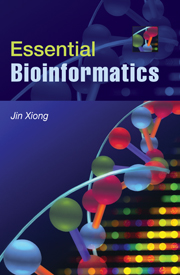Book contents
- Frontmatter
- Contents
- Preface
- SECTION I INTRODUCTION AND BIOLOGICAL DATABASES
- SECTION II SEQUENCE ALIGNMENT
- 3 Pairwise Sequence Alignment
- 4 Database Similarity Searching
- 5 Multiple Sequence Alignment
- 6 Profiles and Hidden Markov Models
- 7 Protein Motifs and Domain Prediction
- SECTION III GENE AND PROMOTER PREDICTION
- SECTION IV MOLECULAR PHYLOGENETICS
- SECTION V STRUCTURAL BIOINFORMATICS
- SECTION V GENOMICS AND PROTEOMICS
- APPENDIX
- Index
- Plate section
- References
7 - Protein Motifs and Domain Prediction
Published online by Cambridge University Press: 05 June 2012
- Frontmatter
- Contents
- Preface
- SECTION I INTRODUCTION AND BIOLOGICAL DATABASES
- SECTION II SEQUENCE ALIGNMENT
- 3 Pairwise Sequence Alignment
- 4 Database Similarity Searching
- 5 Multiple Sequence Alignment
- 6 Profiles and Hidden Markov Models
- 7 Protein Motifs and Domain Prediction
- SECTION III GENE AND PROMOTER PREDICTION
- SECTION IV MOLECULAR PHYLOGENETICS
- SECTION V STRUCTURAL BIOINFORMATICS
- SECTION V GENOMICS AND PROTEOMICS
- APPENDIX
- Index
- Plate section
- References
Summary
An important aspect of biological sequence characterization is identification of motifs and domains. It is an important way to characterize unknown protein functions because a newly obtained protein sequence often lacks significant similarity with database sequences of known functions over their entire length, which makes functional assignment difficult. In this case, biologists can gain insight of the protein function based on identification of short consensus sequences related to known functions. These consensus sequence patterns are termed motifs and domains.
A motif is a short conserved sequence pattern associated with distinct functions of a protein or DNA. It is often associated with a distinct structural site performing a particular function. A typical motif, such as a Zn-finger motif, is ten to twenty amino acids long. A domain is also a conserved sequence pattern, defined as an independent functional and structural unit. Domains are normally longer than motifs. A domain consists of more than 40 residues and up to 700 residues, with an average length of 100 residues. A domain may or may not include motifs within its boundaries. Examples of domains include transmembrane domains and ligand-binding domains.
Motifs and domains are evolutionarily more conserved than other regions of a protein and tend to evolve as units, which are gained, lost, or shuffled as one module. The identification of motifs and domains in proteins is an important aspect of the classification of protein sequences and functional annotation.
- Type
- Chapter
- Information
- Essential Bioinformatics , pp. 85 - 94Publisher: Cambridge University PressPrint publication year: 2006
References
- 4
- Cited by



